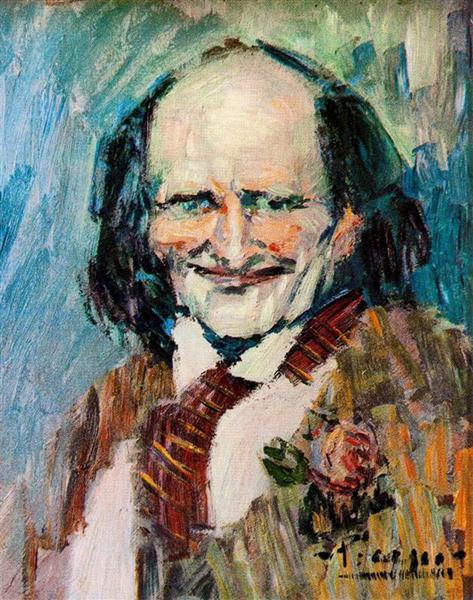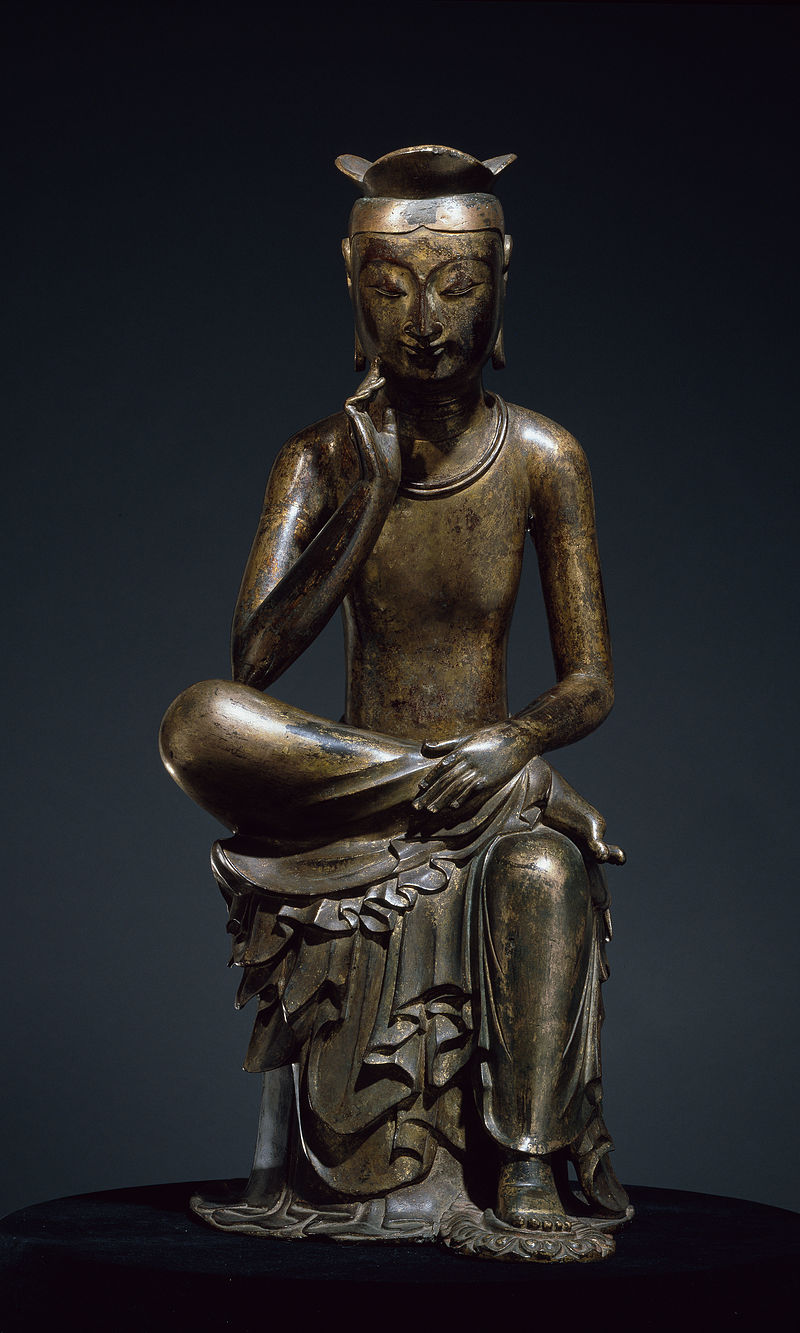In the art world, the colour blue was highly sought after; however, in the Mayan world, it served quite a distinct purpose. As one can see in this portrait, the Virgin Mary has a Mayan quality, if one has studied the works and has categorized the process that the Mayan involved themselves in, in creating the dyes that they used in coloring the special blue dye that were infamously known for. While this essay is not a focus on that process, it is important to know what the color blue meant for Spanish painting left by a footprint procured from the ancient Mayans, specifically in Mexico. Echave was called the ‘Echave of the Blues.’ How can this be? Well, most of the European blue was extracted from the lapis lazuli rock that was imported from Afghanistan; it cost more than its weight in Gold! The Maya, on the other hand, extracted their blue from a special plant that was replete in their region; however, at the time of this painting, it was mixed with something else: the anil plant; consequently, the roots and leaves of this plant would be mixed with a clay called attapulgite, which is the gorgeous blue that is beautifully displayed in this work. This particular shade of blue became a source and symbol of Mayan wealth and holiness; by holiness I mean that sacrificial victims were covered in this blue paint just before the act was executed; in Mary’s case, it would go on to become a symbol of royalty and divine significance to the Spanish people living in Mexico and extinguishing Mayan belief and rituals in exchange for Salvation and Eternal Life that Christianity offered. This painting is an achromatic blend of light and shadow that is inescapable to the viewer; the message in this work is powerful.
Mary is bursting through this painting with bright and deep blue language; she is surrounded on all four corners clothed in clouds with angels carrying various objects that symbolically demonstrate her holiness. For instance, the first angel in the upper right corner is handling a mystical building that was a shrine of some sort for Mexican and Spanish pilgrims; all four corners in the painting are colorful litanies of her exquisite devotion to God and her innocence. The second, third and fourth corners of the clouds and angels occupying them are more of the same; what one should pay careful attention to is the expression of the faces. They are engaged in the profound utterance and wonder of Mary’s admiration by the Holy Spirit, and they are also in awe of her splendid beauty and providence that is displayed by the suspended dove of life over her head, who has embroidered her with miraculous glory and eternity; it is the Gift of her son to us. The bottom cloud of angels is presented engaged in displaying scrolls that would signify her royalty and divine eloquence. The swirling clouds and smiling sunlight dress Mary’s face and wardrobe in heavenly solitude and wondrous mystery, albeit her face is arid. She is wearing a belt high above her waist that highly suggests that she is pregnant with the Christ child; along the elements that float in the painting such as the city, beach and angels in attendance, this might possibly be an accurate suggestion; however, this is quite a bit of interference below her. You have an inverted apparition of the moon that is represented with horns, whose platform is a residence for a black and coiled serpent. This may also suggest that Mary, as a result of her sinless state, has triumphed over any evil associated with her act of giving birth to the Christ child; this is also the strong message of The Gospels, for there is no mention of Satan or any evil during this phase of the Christ story; and it is important to also consider the entire theme of the painting is dressed in angelic/heavenly blue to be emphatic on holiness and innocence these are compulsory ripe ingredients that are needed for a Virgin Birth. Flowers, orchards, clouds, angels, blissful scenes of earthly visions are purposely replete in this work; Mary is part of all of the earthly and cosmic bliss of the heavens and universe; the numerous suns in the paintings candidly represent the connection of God’s providence and his deep attachment to the life of the human spirit, and all of this is under the watchful eyes of the plurality of the moons and suns that loom behind the Virgin’s seemingly embroidered presence; it is preserved for eternity by Mary appearing to suggest homage to God’s gorgeous creation of everything visible to the eye of man.
Bridges, cathedrals, and drippings of basking sunlight are also present to the viewer connecting the visions of distant lands, observed in the background, that echoes the timelessness of the Promised Land that Moses sought to accrue, though they are transcended through the sacrifice of the Virgin’s beloved son. There are also what appear to be silently exalted stars on the bottom of the painting that give The Virgin permission to be Queen of the Universe. Her radiance is exploited to humanity for its own benefit; after all, she remains the Mother of God for eternity, hence the tapestry above her head that is highly evacatory for soteriology.
There is something else that is remarkable in that this painting is conducive to antiquated Mayan grandeur. If one examines the cloistered expressions of the suns and moons in this work, it is revealing to consider that Mary is not alone in her celebrations of life; to the ancient Mayans who inhabited Mexico, the celebration of life was extraordinary; so was sacrificing it! Mary, in all her glory, does not attempt this feat alone, the suns and moons enclose her with radiance and awe that seem to present an everlasting vision of sacrifice and rebirth, the sacrifice of life into death, and the rebirth of the soul into eternity. Death, rebirth and resurrection are a plethora for the veiled Mayan as well as the dilated Christian; that each represented figure in humanity is obtainable of being a forthcoming thirsty person for drinking from the cup of righteousness. Dreamy starlight, prodigal sunlight, and a halo of thirteen stars coronating the Virgin’s head are all about preserving her grand scale of importance on the human race, even those who are alien to her: in this case, the Mayans. By examining her royal blue cloak that is a bit draped with mischievous shades of red, Mary is respondent to all that is around her, but she is also splendidly focused on her divine purpose: to be the Queen of Humanity. The emotions and uncertainties that lag in this portrait are stunning, but they are full of promise and persistently driven. It is almost presented that humanity is dressed in a magnificent dream of the Virgin herself, which is what Ibia longs to demonstrate in this massive structure of myth, reality, providence and annunciation. Is he successful, or does he confuse us even more? Is there too much to interpret and process? I think the viewer is left little to doubt; there are themes on an exaggerated scale, but, I believe, that their purpose is not confounding. Mary is placed in the pandemonium of chaos, life, death, rebirth, eternity and change. She levitates through the center of time with astucious confidence and tameless grace. Her purpose is to arrive, just in time, to save her children, and not just to give birth to The Redeemer. Her giving birth is the tool that saves humankind; it is not just to have The Savior unfold his plot, strike a deal with sacrifice, and become the King of Heaven. The birth of Eternity and Salvation are graciously attached to the acts of nature and time. Nature and time are strong advisors to the viewer of this portrait, not Mary all be herself.
| Artist |
Baltasar de Echave Ibía (ca. 1585 – 1644) – painter (Mexican) |
|
| Title |
Spanish: Inmaculada Concepción
The lmmaculate Conception
|
|
| ainting | ||
| Genre | religious art | |
| Description |
Immaculate Conception of Mary
|
|
| Date | first half of 17th century | |
| oil on canvas | ||
| Dimensions | height: 2,515 mm (99.01 in); width: 1,702 mm (67 in) | |
| Collection | ||
| Accession number |
17961
|
|
| Object history |
English: San Diego Viceregal Painting Gallery, 2000
|
© 2024, Mark Grago. All rights reserved.





